|
|

|
|
Author
|
Topic: SpaceX Dragon CRS-4 flight to the space station
|
Robert Pearlman
Editor Posts: 42988
From: Houston, TX
Registered: Nov 1999
|
 posted 09-19-2014 09:25 PM
posted 09-19-2014 09:25 PM
   
SpaceX release SpaceX CRS-4 Mission OverviewAfter four missions to the International Space Station (ISS), including three official resupply missions for NASA, SpaceX is set to launch its fourth Commercial Resupply (CRS) mission to the orbiting lab. SpaceX's CRS-4 mission is targeting launch on Sunday (Sep. 21) at 1:52 a.m. EDT (0552 GMT) from Complex 40 at the Cape Canaveral Air Force Station, Florida. If all goes as planned, Dragon will arrive at the station on Tuesday (Sept. 23) for an expected four-week visit. Dragon is scheduled to return to Earth in mid-October for a parachute-assisted splashdown off the coast of southern California. Background and purpose SpaceX CRS-4 is the fourth of 12 missions to the International Space Station that SpaceX will fly for NASA under the Commercial Resupply Services (CRS) contract. In December 2008, NASA announced that SpaceX's Falcon 9 launch vehicle and Dragon spacecraft had been selected to resupply the space station after the end of the shuttle program in 2011. Under the CRS contract, SpaceX has restored an American capability to deliver and return significant amounts of cargo, including live plants and animals, to and from the orbiting laboratory. 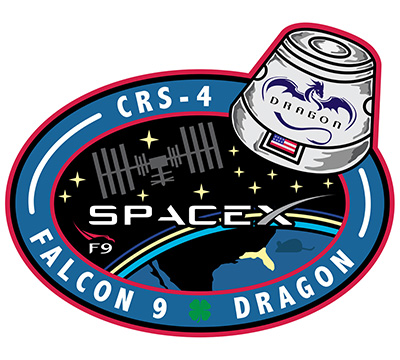 Cargo Dragon is filled with more than 5,000 pounds (2,300 kg) of supplies and payloads, including critical materials to support 255 science and research investigations that will occur during Expeditions 41 and 42. Dragon is carrying three powered cargo payloads in its pressurized section and two in its unpressurized trunk. Dragon will return with about 3,800 pounds (1,700 kg) of cargo, which includes crew supplies, hardware and computer resources, science experiments, space station hardware, and four powered payloads. For the first time, Dragon is carrying live mammals — 20 rodents are riding in NASA's Rodent Research Facility, developed at NASA Ames Research Center. The rodent research system enables researchers to study the long-term effects of microgravity — or weightlessness — on mammalian physiology. Other science payloads include the ISS-Rapid Scatterometer to monitor ocean surface wind speed and direction; a study of a small flowering plant related to cabbage that allows scientists to study plant growth and adaptations in space; and several new technology demonstrations, including the Special Purpose Inexpensive Satellite, or SpinSat, which tests how a small satellite moves and positions itself in space using new thruster technology and the 3-D Printing In Zero-G Technology Demonstration, which will be the first ever 3-D printer in space. See here for discussion of SpaceX's fourth Dragon CRS flight to the ISS. |
Robert Pearlman
Editor Posts: 42988
From: Houston, TX
Registered: Nov 1999
|
 posted 09-21-2014 01:58 AM
posted 09-21-2014 01:58 AM
   
collectSPACE SpaceX Dragon capsule lifts off for station with mice and more aboardThe mission patch for SpaceX's fourth NASA-contracted resupply flight to the International Space Station, which launched on Sunday (Sept. 21) from Florida, has everything you would expect from an emblem of its type, and something you might not. Almost hidden among the patch's depictions of the Dragon space capsule, the orbiting laboratory and the Earth is a mouse. But that's because there are mice — 20 black, all-female mice to be exact — onboard the commercial cargo spaceship. The "moustronauts" lifted off for the space station at 1:52 a.m. EDT (0552 GMT) onboard SpaceX's sixth Dragon to fly since 2010. Soaring to space atop a two-stage SpaceX Falcon 9 rocket, the Dragon's launch lit up the night sky as it climbed from Complex 40 at the Cape Canaveral Air Force Station. 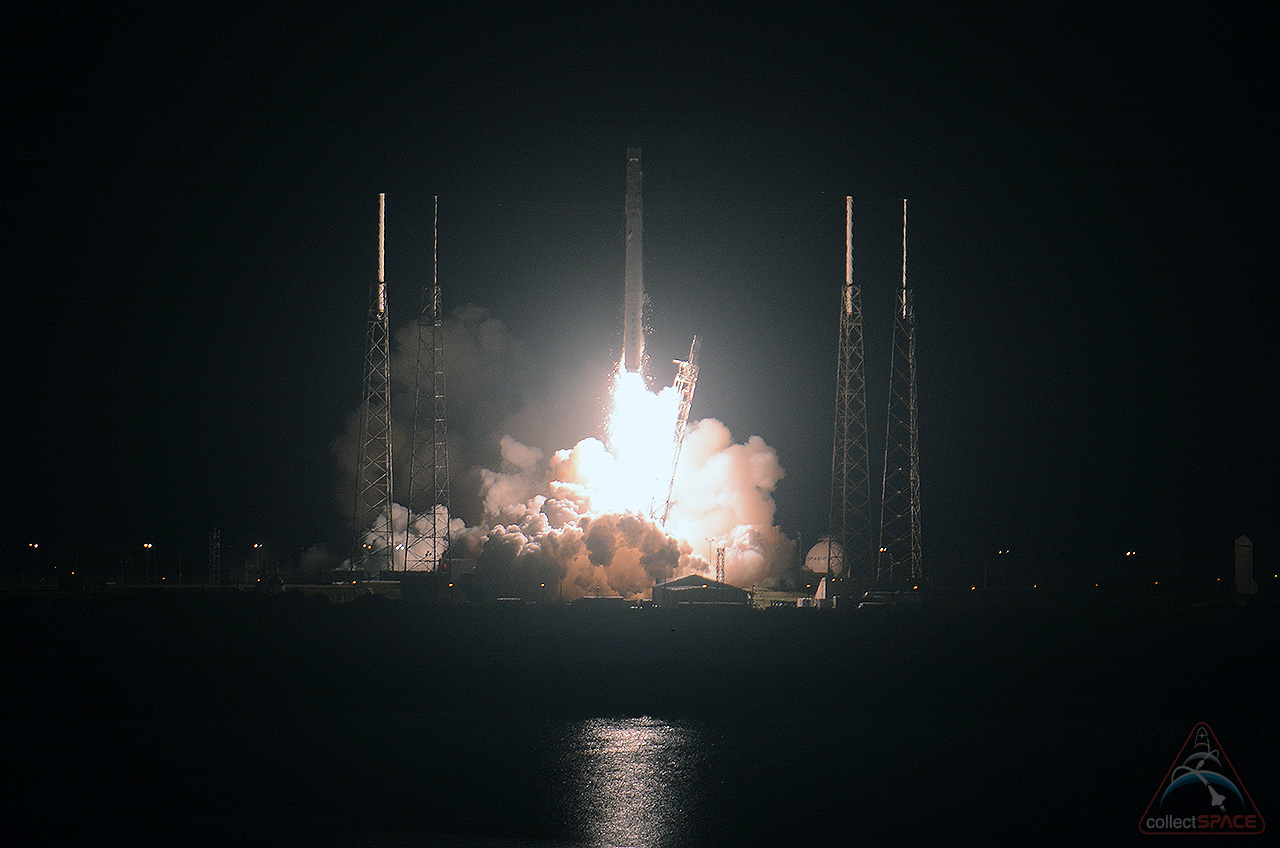 |
Robert Pearlman
Editor Posts: 42988
From: Houston, TX
Registered: Nov 1999
|
 posted 09-23-2014 06:45 AM
posted 09-23-2014 06:45 AM
   
SpaceX Dragon arrives at space stationSpaceX's CRS-4 Dragon spacecraft completed its two-day trip to the International Space Station early Tuesday morning (Sept. 23). NASA astronaut Reid Wiseman and European Space Agency (ESA) astronaut Alexander Gerst were in the space station's Cupola when they used the Canadarm2 robotic arm to capture the Dragon at 5:52 a.m. CDT (1052 GMT). The Dragon will spend the next four weeks attached to the station's Harmony node as the Expedition 41 crew unloads 4,885 pounds of crew supplies, hardware, experiments, computer gear and spacewalk equipment. |
Robert Pearlman
Editor Posts: 42988
From: Houston, TX
Registered: Nov 1999
|
 posted 10-25-2014 09:34 AM
posted 10-25-2014 09:34 AM
   
Dragon departs station for ocean splashdownSpaceX's CRS-4 Dragon cargo spacecraft is on its way back to Earth, having left the International Space Station on Saturday (Oct. 25). The gumdrop-shaped capsule was released from the space station's Canadarm2 robotic arm at 8:57 a.m. CDT (1357 GMT). 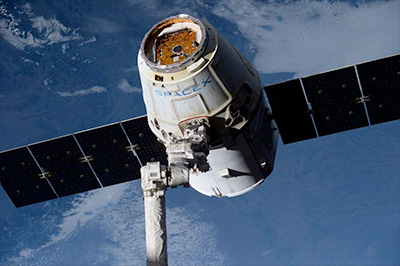 Flying free again after five weeks berthed to the orbiting laboratory, the Dragon completed a series of departure burns and maneuvers to move away from the space station and begin its return trip to Earth. The capsule is scheduled to splashdown in the Pacific Ocean at 2:39 p.m. CDT (1939 GMT), about 265 miles (430 kilometers) west of the Baja peninsula. The Dragon is carrying more than 3,276 pounds (1,486 kilograms) of NASA cargo and science samples from human research, biology and biotechnology studies, physical science investigations and education activities sponsored by NASA and the Center for the Advancement of Science in Space (CASIS), the nonprofit organization responsible for managing research aboard the U.S. national laboratory portion of the space station. 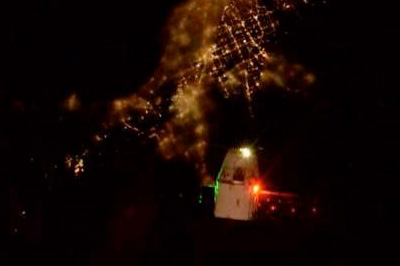 Above: SpaceX's Dragon sails over a cloudy Sydney, Australia as it departs the space station. (NASA/Reid Wiseman) |
Robert Pearlman
Editor Posts: 42988
From: Houston, TX
Registered: Nov 1999
|
 posted 10-25-2014 04:38 PM
posted 10-25-2014 04:38 PM
   
NASA release Critical NASA science returns to Earth aboard SpaceX Dragon spacecraftSpaceX's Dragon cargo spacecraft splashed down at 3:39 p.m. EDT (1939 GMT) Saturday, Oct. 25, in the Pacific Ocean, approximately 300 miles (430 kilometers) west of Baja California, returning 3,276 pounds (1,486 kilograms) of NASA cargo and science samples from the International Space Station (ISS). A boat will take the Dragon spacecraft to a port near Los Angeles, where some cargo will be removed and returned to NASA within 48 hours. Dragon will be prepared for a return journey to SpaceX's test facility in McGregor, Texas, for processing. 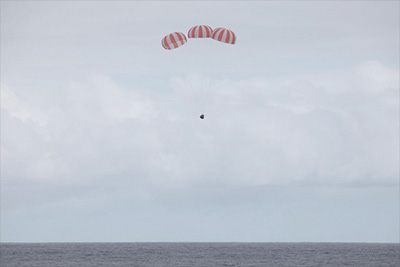 "This mission enabled research critical to achieving NASA's goal of long-duration human spaceflight in deep space," said Sam Scimemi, director of the International Space Station division at NASA Headquarters. "The delivery of the ISS RapidScatterometer advances our understanding of Earth science, and the 3-D printer will enable a critical technology demonstration. Investigations in the returned cargo could aid in the development of more efficient solar cells and semiconductor-based electronics, the development of plants better suited for space, and improvements in sustainable agriculture." Among the returned investigations was part of the Rodent Research-1 experiment, which also launched last month to space aboard this Dragon. This study supports ongoing research into how microgravity affects animals, providing information relevant to human spaceflight, discoveries in basic biology, and knowledge that may direct affect human health on Earth. NASA and the Center for the Advancement of Science in Space (CASIS) are developing spaceflight experiments that will use the Rodent Research Hardware System. When returned, data from the Fundamental and Applied Studies of Emulsion Stability (FASES) investigation will be processed to help determine the physical principles which play a part in stabilizing different emulsions and the compounds that influenced those emulsions while in orbit. Emulsions are mixtures of two or more liquids where one liquid is present in droplet form and distributed throughout the other liquid; common emulsions include milk, mayonnaise and paint. NanoRacks-Girl Scouts of Hawai'i-Arugula Plant Growth study was returned to Earth, as well. This study seeks to determine the impact that various nutrients and microgravity have on the growth and nutritious value of arugula seedlings grown in space. The goal of the study is to develop better ways to grow plants with a high nutritional content in the space environment. If the study samples have a high nutrition value, this may enable NASA and astronauts to grow and consume fresh, healthy food during future space travel. Dragon is the only space station resupply spacecraft able to return a significant amount of cargo to Earth. The spacecraft lifted off from Cape Canaveral Air Force Station in Florida on Sept. 21 carrying almost 5,000 pounds of supplies and elements to support 255 scientific investigations the crew members of Expeditions 41 and 42 will conduct. The mission was the fourth of 12 cargo resupply trips SpaceX will make to the space station through 2016 under NASA's Commercial Resupply Services contract. See here for discussion of SpaceX's fourth Dragon CRS flight to the ISS. | |
Contact Us | The Source for Space History & Artifacts
Copyright 2020 collectSPACE.com All rights reserved.

Ultimate Bulletin Board 5.47a
|
|

|
 advertisement advertisement

|
















